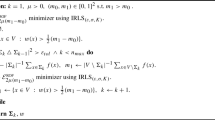Abstract
We show that three distinct orthographic views of three points in a rigid configuration are compatibel with at most 64 interpretations of the three-dimensional structure and motion of the points. If, in addition, one assumes that the three points spin about a fixed axis over the three views, then with probability one there is a unique three-dimensional interpretation (plus a reflection). Moreover the probability of false targets is zero. In the special case that the axis of rotation is parallel to the image plane three views of the three points are sufficient to obtain at most two interpretations (plus reflections)-unless one assumes the angular velocity about the axis is constant, in which case three views of two points are sufficient to determine a unique interpretation. Closed form solutions are obtained for each of these cases. The systems of equations studied here are in each case overconstraining (i.e. there are more independent equations than unknowns) and are amenable to solution by nonlinear programming. These two properties make possible the construction of noise insensitive algorithms for computer vision systems. Our uniqueness proofs employ the Principle of upper semicontinuity, a principle which underlies a general mathematical framework for the analysis of solutions to overconstraining systems of equations.
Similar content being viewed by others
References
Atiyah-Macdonald M (1969) Introduction to commutative algebra. Addison-Wesley, Reading, MA
Bennett BM, Hoffiman DD (1985) The computation of structure from fixed-axis motion: nonrigid structures. Biol Cybern 51:293–300
Bobick A (1983) A hybrid approach to structure-from-motion. Proceedings of the ACM Workshop on Motion: Representation and perception
Braunstein M (1976) Depth perception through motion. Academic Press, London
Gibson JJ (1950) The perception of the visual world. Houghton Mifflin, Boston
Gibson JJ, Gibson EJ (1957) Continuous perspective transformations and the perception of rigid motion. J Exp Psychol 54:129–138
Green BF (1961) Figure coherence in the kinetic depth effect. J Exp Psychol 62:272–282
Grothendieck A (1961) Eléments de géometrie algebrique. III. Etude cohomologique des faisceaux cohérents. Publications Mathematiques de l'Institut des Hautes Etudes Scientifiques 11
Hartshorne R (1977) Algebraic geometry. Springer, New York Berlin Heidelberg
Hay CJ (1966) Optical motions and space perception—an extension of Gibson's analysis. Psychol Rev 73:550–565
Helmholtz H (1925) Treatise one physiological optics. In: Southall JPC (ed) Dover, New York
Hoffman DD (1982) Interring local surface orientation from motion fields. J Opt Soc Am 72:888–892
Hoffman DD (1983) The interpretation of visual illusions. Sci Am 249:154–162
Hoffman DD, Flinchbaugh BE (1982) The interpretation of biological motion. Biol Cybern 42:195–204
Johansson G (1975) Visual motion perception. Sci Am 232:76–88
Longuet-Higgins HC, Prazdny K (1980) The interpretation of a moving retinal image. Proc R Soc Lond Ser B 208:385–397
Reuman S, Hoffman DD (1986) Regularities of nature: their role in the interpretation of visual motion. In: Pentland AP (ed) From pixels to predicates: recent advances in computational vision. Ablex Publishing, New York (in press)
Ullman S (1979) The interpretation of structure from motion. Proc R Soc Lond Ser B 203:405–426
Wallach H, O'Connell D (1953) The kinetic depth effect. J Exp Psychol 45:205–217
Webb J, Aggarwal J (1982) Structure from motion of rigid and jointed objects. Artif Intell 19:107–130
Author information
Authors and Affiliations
Rights and permissions
About this article
Cite this article
Hoffman, D.D., Bennett, B.M. The computation of structure from fixed-axis motion: rigid structures. Biol. Cybern. 54, 71–83 (1986). https://doi.org/10.1007/BF00320477
Received:
Issue Date:
DOI: https://doi.org/10.1007/BF00320477




